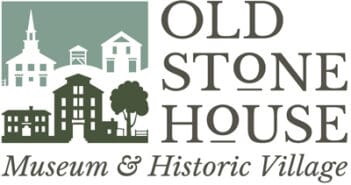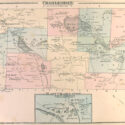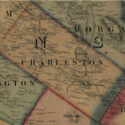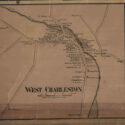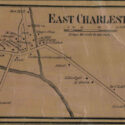Town Facts:
- First grant of land: 1780
- Chartered: 1780, to Hon. Abraham Whipple, his shipmates and others.
- First survey: 1794
- First trees felled: 1802
- First crops planted: potatoes, 1802
- First settler: Abner Allyn
- First family to move into town: Andrew McGaffey, 1803
- First town meeting: 1806
- Original name: Navy, until 1825
- Local farms produced potatoes for starch factories.
- Hops were grown in Charleston in the 19th century.
- Granite was once quarried in Charleston.
Two villages:
- East Charleston: Jonas Allen built the first saw mill in East Charleston in 1824. John Cushman built a gristmill in 1834. Industries in 1870 included three lumber mills, one planing and clapboard machine, one shingle mill, one shop for making butter firkins, and two starch factories. First church building in E. Charleston constructed in 1855.
- West Charleston: L. Sturtevant and S. Cole built a gristmill in 1810. Industries in 1870 included two lumber mills, two carding machines, one emery wheel factory and one starch factory. Orthodox Congregational Church organized in 1844, Congregational Church building constructed from 1854 to 1859. Stone Church called the Union House.
Town History
From the Vermont Historical Gazetteer, edited by Abby Maria Hemenway. Orleans County – Charleston Chapter: Published by Claremont Manufacturing Co, 1877. Pgs 106-110
BY ALPHA ALLYN, ESQ.
This township, situated in the easterly part of Orleans County, is in lat. 44° 51′, and long. 4° 53′ bounded N. E. by Morgan, S. E. by Brighton, S. W. by a part of Westmore and Brownington, and N. W. by Salem; and lies 50 miles N. E. of Montpelier. It was granted to Gov. Thomas Chittenden the 6th, and chartered the 8th of Nov., 1780, to Hon. Abraham Whipple, his shipmates and others; containing 23,040 acres. Commodore Whipple was a distinguished naval officer in the Revolutionary war, and he first named this township Navy, in honor of the American navy which he so bravely defended. This tract was originally divided into 69 equal shares. By the terms of the charter one share was granted for the first settled minister, one for glebe, one for support of town schools, one for support of grammar school, and one for college.
None of the original grantees ever resided in town, and but three- John L. Chandler, Elisha and Andrew Brown-were ever known to come here. The most of them lived in Cranston, Providence and Johnson, R. I. One of them, Charles Murray, lived in London England, and never resided in, or saw America. Samuel Knight, one of the voters at the organization of the town, settled in 1806. A few of the descendants of the original grantees came here about 1831 and settled on their grandfathers’ “rights.”
The first three roads were located by the proprietors, according to written contract for the benefit of these lots and the settlements thereon; the first from Brownington to Holland; the second, called the Westmore county road, passed from Burke through Westmore and the centre of Navy, (now Charleston) on the west side of Echo pond, thence by Seymour lake and Morgan four corners, on by the farm of Eber Robinson, in Holland, to Barnston, C. E. In 1816, fishermen and hunters, who were accustomed to come into this town, drawn thither principally by the abundance of lunge (sic) and other fish found in Echo pond, discovered that their route might be shortened by a road from Mr. Wellman’s, 2 miles north of Burke Hollow, on the Westmore road, through Charleston on the east side of Echo pond-connecting with said Westmore county road south. Through their efforts this new county road was laid, which was a great help to both East and West Charleston.
The proprietors and agents, together with the settlers on the gift land, entered into a written contract agreeing to have two sets of mills-one in the east, the other in the west part of the town. Col. Christopher Olney, of Providence, R. I., who owned 2 rights of land in this town, gave 50 acres as an inducement for building the first grist-mill at West Charleston, provided he could have for the benefit of the settlement of East Charleston, instead of a draft- said lot containing the mill-privilege- and also have the pine lot left out of the draft of the second division. By this means the first mills in both East and West Charleston were erected, some years after.
The soil of this township is a rich loam, producing good crops. The alluvial fiats along the stream of the Clyde are extensive, and many of them too low for cultivation; but improve as years pass, which strengthens the theory of a long pond, which is supposed to have discharged its waters into Memphremagog lake before the famed Glover pond transit in 1810. In the south-east part of the township is a bog meadow, which contains 500 acres in one body. The climate in this section has ever been considered healthful. During the first 22 years of the settlement of the town only 13 deaths occurred, and but 3 of those, adults.
Clyde river is the largest stream in town. It rises in Spectacle pond in Brighton, thence flowing through Island Pond into this town, in a north-westerly direction, nearly through its centre. On this stream are some falls of importance, particularly the Great Falls in the west part of the town, where the descent is more than 100 feet in 40 rods; but its current generally slow. The principal tributaries of the Clyde are Ferrin’s river from the north, and the waters of Suke’s pond through a brook; then the waters of Coe’s Copper brook, Morgan Gull brook, also, the stream from Cole’s pond in Brighton; next Buck’s brook from Brighton, Mad brook from Westmore and Echo pond brook at the East village next Fenner brook from Westmore, then the Nutting brook from Boardway pond, and Toad pond brook from Toad pond. These all flow into Clyde river above Pension pond in this town.
Echo pond, situated in the easterly part of the township, receives the waters of Seymour lake in Morgan, and through that the waters of Holland pond. Echo pond is a beautiful sheet of water one mile from the East village, whose mill-privileges are supplied by its waters through the brook which is its outlet. It is one mile and a half long, and one mile wide. Gen. Whitelaw gave it the name of Echo pond from the fact that when any sound was produced in its vicinity it was reverberated in various directions, producing succession of echoes. It has been said that seven have been distinctly counted from one sound. This was when the surrounding terra firma was covered with an unbroken forest.
Pension pond is the next in size, and was so named by Abner Allyn on account of the pension of Mr. Varnum, a Revolutionary soldier, being used to build a mill-dam and saw-mill in 1820 near the Great Falls, by his son George Varnum. Toad pond is above Pension pond near the great swamp on Brownington line. Boardway pond is near Morgan line.
This township was an unbroken wilderness until 1802, uninhabited by man, except we give credit to Indian testimony hereafter introduced. In June of this year Abner Allyn felled the first trees in town, on lot No. 4, first division, and planted potatoes the 5th of August, which he brought on his back from Barton, a distance of 12 miles. He had a good yield of large potatoes, which were well preserved in an out-of-door cellar until the next spring, when he planted them and had early potatoes, and also sowed grain. In July, 1803, he moved his family here from Barton, where they had lived preparatory to their more pioneer life in the wilderness. During his residence in Barton, he had been an active citizen in all that pertained to the public good, and was first town clerk of that town. He moved into a log-house in Charleston, the floor of which was made of hewed logs, and the roof covered with bark.
The town of Navy was organized March 31, 1806, by Elijah Strong, justice of the peace from Brownington.
In 1808 there were 11 voters, viz.: Abner Allen [sic], Jeremiah Seavey, Wm. Merriam, Benj. Teel, Lemuel Sturtevant, Samuel Knight, Orrin Percival, Samuel Morrison, Jonathan Richards, Philip Davis, Robert H. Hunkins. In 1809 the voters were the same, with Jonas Warren added. In 1810, Stephen Cole, Thomas Ames, Willard Marshall, Ephraim Hartshorn, Frederick Wilkins, Phineas Underwood, making 18 voters. In 1811, Zacheus Senter, Robert Nichols and Levi Bradley were added. This year the number of voters was 17. In 1814, on account of the cold season, the war, and the fear of Indians whom, it was reported, were coming to their settlements, half of the voters left the town of Navy not to return; and also all of the settlers in Westmore and East Brownington.
There were no more added to the eleven voters left in Navy until 1819, excepting Jonas Warren, Jr., who had become of legal age to vote. The voters in 1818 were Philip Davis, Abner Allyn, Phineas Underwood, Samuel Hutchinson, Ebenezer Cole, Elisha Parlin, Stephen Cole, Jonas Warren, Jr. This year there were 12 voters with but 11 families. This little band, unflinching and true, endured almost every conceivable hardship and privation during the war and cold seasons, rather than abandon their settlement. For about 3 years the grain crop was very light, and they were obliged to go to Bradford and Newbury for corn, and to Barnet and Ryegate for oatmeal, as a substitute for other bread. These families, all except Z. Senter, lived on the two west tiers of lots adjoining Salem line; and the road from Brownington to Holland was all on these lots.
In 1820 the whole population was 100.
At the time of the first settlement of West Charleston, the nearest saw-mill, grist-mill and Store was in Barton, 12 miles distant. The nearest post-office was in Brownington. The road was unworked-the trees and underbrush cut away; but being hemmed in on both sides by thick forests, rains did not soon either evaporate, drain off, or settle into the ground; so that travel was of necessity almost impossible. The writer has heard Abner Allyn say, that he has traveled back and forth on horseback carrying to and from home the necessaries for existence when his horse’s legs sank so deep in the mud, that his own feet touched the ground, and that so heavy was the mud as to cause suction strong enough to actually draw the shoe from the horse’s foot.
He said at one time he alighted, took off his coat, raised his sleeve to his shoulder, thrust in his hand and arm above his elbow, grasped the horse-shoe, drew it up and carried it to be re-set at the nearest blacksmith-shop. He related that at another time there was a heavy rain which beat into his log-house and put out all their fire. As the flint was their only way to strike fire, he often resorted to that; but unfortunately he had lent his gun to some hunters to be gone for days; so there was no other alternative than to leave his family in bed to keep from freezing, while he went to his neighbor, Judge Strong’s, 4 1/2 miles away to borrow fire. He did not like to tell of his calamity, so he asked to borrow the Judge’s gun- returned with it, and struck fire, by which time wife and children were glad enough to rise.
At one time this family awoke in the night and found their house on fire. They had no modern fire-department, or even neighbors to call; so they managed as best they could. They carried a bed out of doors, put the children snugly into it, tucking up the bed-clothes well, to prevent them from getting out into the deep snow- then they went to work and took the entire roof off from the house; thus saving the rest of the house and its contents. Mr. Allyn was then obliged to take his team and go through the deep snows 12 miles to Barton, to draw boards with which to cover his house.
Great must have been the courage and bravery those lone settlers thus to surrender their best days, enduring almost every conceivable hardship and deprivation, not merely for their own pecuniary benefit, but to lay the foundation for the future good of this section of our country.
The early settlers in the east part of the town endured like hardships with those of the west. They went to Burke, 14 miles distant, for all their supplies, except milling-pressing a mountainous ridge, the rise and fell being several miles. It was called the ten-miles woods; and when some bold adventurer had dared to make a pitch there, and fall a few acres of trees, it really seemed to shorten the distance- an oasis in the wilderness. Joseph Dickey was the first to settle on the new County road in East Charleston, on the east side of Echo pond.
Dickey was an honest, upright man -the first tailor in town. His son Solon lost his life by the fall of a tree, Jan. 9, 1825, and was buried in the first grave-yard, in East Charleston. His Father erected a suitable memorial-stone over his grave; but as he had moved out of town before the people laid out a new burial-ground, and exhumed most of their dead, a man from another county purchased the farm, and plowed the grave-yard. About this time the stone with the name of Solon Dickey disappeared. Therefore the exact resting-place of his mortal dust is unknown.
It was 7 miles from Jonas Allen’s to Cole’s mills, by direct route; but in the early settlement of East Charleston there was no road down the river, and the settlers were obliged to go round by Morgan Four Corners, a distance of about 12 miles, to get to Cole’s mills in West Charleston, the only grist-mill in town, excepting they went down the river in boats, as they sometimes did ; in which case they could only go to the Great Falls, one mile from the mill-then unload and transport their grain and meal back and forth upon their backs.
There was no inhabitant up the river nearer than Enos Bishop’s, on the shore of Island pond, 7 miles distant, and no road. Jonas Allen and others were obliged to go to Morgan, the nearest saw-mill, 8 miles distant, to draw their boards for building purposes. In the fall of 1823, through the instrumentality of Abner Allyn a road was made from East to West Charleston, greatly remedying these inconveniences. In 1824 Jonas Allyn purchased land where the East village now stands, at $1.50 per acre, where he erected a saw-mill. From this time the settlement progressed more rapidly. Settlers came in for the benefit of the heavily timbered pine lot, for which each, by paying the owner of the undivided share the sum of $5.00 had a right to draw all the timber he chose from the lot. They drew the sawed lumber to Burke and St Johnsbury by which means they obtained provisions for their families, and were also enabled to make clearings and other improvements on their land.
In 1826 a county road was laid from Derby to Brighton, past East and West Charleston. Land-tax was laid out on this road in 1827.- This made a comfortable road from Derby to St. Johnsbury.
Lemuel Sturtevant and Stephen Cole built the first grist-mill at West Charleston, in the year 1810. Stephen Cole also built the first framed house at West Charleston in 1811. The first saw-mill at East Charleston was erected by Jonas Allen in 1821, just above the present site of the dwelling-house of L. N. Melvin.- Stephen Cole put a small run of stone in the lower part of this saw-mill in 1827, which ground com and provender. John Cushman built a good grist-mill here in 1834, where the present one, owned by C. H. Chase, now stands.
The first saw-mill at West Charleston was by Jonas Warren in 1809. The first hotel at West Charleston was erected and kept by Ira Richards in 1822. The’ first hotel at the east part of the town was built and kept by John Cushman in 1827. The first carding-machine and clothing-works in town were erected at East Charleston in 1831, by Harvey Holbrook, and run by Harvey H. Cloud, both of Waterford Vt.
Ira, son of Jonathan Richards, was the first merchant in town in 1822. Lewis C. Bates was the first merchant at the east part of the town in 1831. The first physician in West Charleston was Ezra Cushing in 1822. The first physician in East Charleston was Cephas G. Adams in 1855. The first lawyer was F. C. Harrington, who was also editor of the North Union-first yearly newspaper printed in town. The first military company was formed in 1822, and Ira Richards (now in Wisconsin) first captain. Timothy Hazeltine, who moved to East Charleston in 1828, was the first blacksmith in town. The first shoemaker in town was Chauncey Fuller, who moved from Waterford to West Charleston, in 1824.
The first two marriages in this town were Ebenezer Bartlett and Eunice Cole– Elisha Parlin and Elizabeth Warren – married Feb. 3, 1815, by Ira Leavens, justice of the peace, of Morgan. There was no school-house in town before the year 1822, but the children had a few advantages from private schools supported by the scholar. The first two schools were kept in Orrin Percival’s barn, on lot 12, in the 1st division. The first school-house was erected where the West village now stands, near the present site of the Clyde River Hotel. The first teachers were Sally Hopkins, of Salem, Zilphia Gory, of Derby, Sally Buekman, of Lancaster, N. H., and Eunice Cole, of Charleston. Miss Gory married Lemuel Sturtevant, one of the first settlers this town. Miss Cole married Ebenezer Bartlett, one of the early settlers of Morgan.- She was sister of Ebenezer and Stephen Cole, early settlers of Charleston-all three of whom raised large families who have been enterprising citizens in these towns. Many of them are still living. Miss Buckman married Peleg Hicks, of Burke. She was grand-daughter of the remarkable pioneer, known from his bravery as Gov. Page, who penetrated the forests of Lancaster, N. H., and Lunenburg, Vt, making the first settlements there; and who also did much for the success of Guildhall as a new settlement.
November 16, 1825, the name of Navy was changed to Charleston. In 1831 Abner Allyn made out a petition which he sent to Congress for a mail route from Lyndon to Derby. The route was granted and post-masters appointed. This was the first U. S. mail route through Charleston. Truman Newell Esq., of Burke, was mail carrier for the first 4 years.
Back To Top
CHURCH STATISTICS.
The first church edifice in town- stone house now standing -was erected at West
Charleston, in the year 1843. The first church erected at East Charleston was in 1855. The first sermon preached in town was by Rev. Luther Leland, Congregationalist, from Derby at Mrs. McGaffey’s funeral. From that time until 1806, meetings were held occasionally at the Congregationalist and Calvinist Baptists at the dwelling-house of Abner Allyn. About the year 1806, Methodist meetings commenced-the circuit embracing nearly the whole county. From this time until 1812, Methodist meetings were held at the dwelling-houses of Abner Allyn and Robert Hunkins, with the exception of the time of the first reformation in 1810, when the meetings were held at the dwelling-houses of Stephen Cole and Jona. Richards. This reformation was under the preaching of the Methodists. The larger part of the people who attended these meetings were from Morgan and most of the converts since from that town.
The names of the converts from Charleston were Joseph Kellam, John Bishop and Ira Richards. Joseph Kellam and Jonathan Richards united with the Methodists; the former of whom has since been one of the greatest reformation preachers in New England. The first persons baptized in town were Stephen Cole and wife and Sam’l Hutchinson, in 1818, by Rev. Moses Norris. In 1823, Jonas Allen, first ordained minister in town, moved here from Waterford and preached 7 years in both East and West Charleston. This with Rev. Royal Gage-local Methodist preacher-and the circuit preaching concluded the religious worship up to 1832, with the exception of Baptist preaching given in another place.
In 1834 Jonas Allen removed to Madison, Ohio, where he died 2 years since. Orson Pratt and Lyman E. Johnson, Mormon priests, came to town in 1832, formed a large church from East Charleston and Brighton; but in a few short years this whole church with the exception of one who renounced the faith, gathered up their effects and removed to Missouri their “Promised Land. This sect professed to work miracles, heal the sick and performed all to the satisfaction of their followers. Their numbers were greatly increased through the faith of the people in the healing of a Mrs. Fair who on account of sickness had been unable to leave her bed for 3 years. After a season of prayer, the Mormon priests commanded her to “rise and walk”; upon which she immediately obeyed the injunction, declared herself healed, and the next day was baptized in the waters of the Clyde. After which she engaged in the busy avocations of active life during the remaining 4 years of her stay in Charleston.
From 1832 to 1843, the writer thinks had Methodist preaching in East Charleston once in about 4 weeks, with occasionally some Congregational, Calvinist and Free-will Baptist preaching. The first Methodist class was formed at East Charleston in 1833. The first Sabbath school formed at East Charleston was in 1837, and Anson Sanborn first superintendent. In 1843, this year of the Advents, Charleston had its full share; and they continued their stay several years, holding meetings regularly during the whole period. Besides this the principal preaching in East Charleston from 1843 to 1861, was Freewill Baptist and Methodist. From that time until the present year, 1889, Methodist and Freewill Baptist preaching have each been sustained one half the time.
FREEWILL BAPTIST CHURCH.
BY REV. R. C. SMALLEY.
It appears by the record that the F. W. Baptist church was the first one organized in town, and the organization took place Feb. 11, 1830, by a council composed of Revs. J. Woodman, Daniel Quimby and Abel Bugbee. Joel R. Hidden was the first clerk. Jonas Allen was a member of the church, but whether he was pastor or not does not appear on the record. 16 members composed the church at first, and for a number of years it was, in a measure prosperous, and enjoyed some good revivals.
As the town became more settled other denominations came in, and the Baptist church for a time had no stated preaching. After a lapse of some years the interest again revived, and two churches were organized called East and West Charleston churches; and both are now trying to sustain the Gospel in their borders. The pastors at the West church have been, Revs. T. P. Moulton, D. Waterman, J. Whittemore and C. H. Smith. The church now reports only 24 members.
The East church in 1862, secured the labors of Rev. E. C. Heath who labored until May 1865. During his ministry the church enjoyed some prosperity and received additions in numbers and influence. In May 1865, the writer became pastor of this church, and has continued until the present season to labor here a share of the time. Present No. of members, 44. The West church own a house of worship. The East church worship in a Union house with E. Methodists and Universalists.
INDIAN HISTORY OF “LONG POND.”
According to Indian testimony there was once a long pond in this town, extending
along the course of Clyde river from the Great Falls in Charleston, up into Brighton. There are broad meadows along the course of the river, swamps and deep muck-beds. Though the soil is deep in most of the meadows, yet in some places there is no soil to speak of- hardpan, close to the surface. At the time of the first settlement of the town, many of the bog meadows could not be crossed in safety.
I had often heard the inhabitants allude to these, with other peculiarities, as indicative of great changes which had been effected by some means, since the original creation. From them I learned that the story in regard of the matter was of Indian origin, made known to them through the St. Francis tribe, who were accustomed to migrate through the town, sometimes twice a year, stop and pitch their tents on lot No. 33, where the East village now stands, staying a longer or shorter time as best suited them-hunting etc.
In 1824, after Jonas Allen had settled on this lot I chanced to be at his house, and was informed of the Indian encampment on their lot at that time. The men being out on a hunting excursion, I stopped until their return in purpose to ferret out if possible more of this Indian tradition. When they came in, they brought a large deer of which I purchased a part to carry to my home in West Charleston. Fortunately this company consisted of some old as well as young men. From the former I gleaned, what seemed to me, a plausible story taken in connection with the actual phenomena of our bogs and swamps.
They said it had been fifty years since they with their fathers, had made a permanent home at that place; at which time they remained 9 consecutive years; and during the whole of that period there was a long pond there, 10 miles in length, with two outlets one by a stream into Willoughby river, thence to Memphremagog lake. The other outlet through Clyde river into Salem pond, thence to Memphremagog lake. They also said that the waters of this Long pond ran away to Memphremagog before those of Glover Pond, and that they were knowing to the facts of both at the time of the events.
The reason they assigned for making this place their home at that time, was because of a division among their own tribe, they being in favor of the English, and the rest in favor of the French at the time of the French and Indian war. They remained- according to the testimony given- until after peace was concluded between the French and English in 1763, then returned to Canada. They showed where they camped, where they put their furs and potatoes, and also showed old marks on maple trees where they had been tapped 9 years in succession. This sugar lot, which was one of their camping-grounds, was situated on both sides of the town line between Charleston and Brighton; on lot No. 37, 1st div. in Brighton and lot No. 95, 1st division in Charleston. They related each circumstance so clearly from time to time, and gave the several proofs with so much correctness, that no one doubted the truthfulness of their assertions.
And as years have passed from that interviewee the present, the changes observed in the meadow lands, corroborate their testimony. The bog meadows that a man could not cross in safety in 1803, had so much increased in density, that in 1824, hay was cut and carried out by hand. Now both people and teams pass over them secure from danger, only in some exceptional cases.
